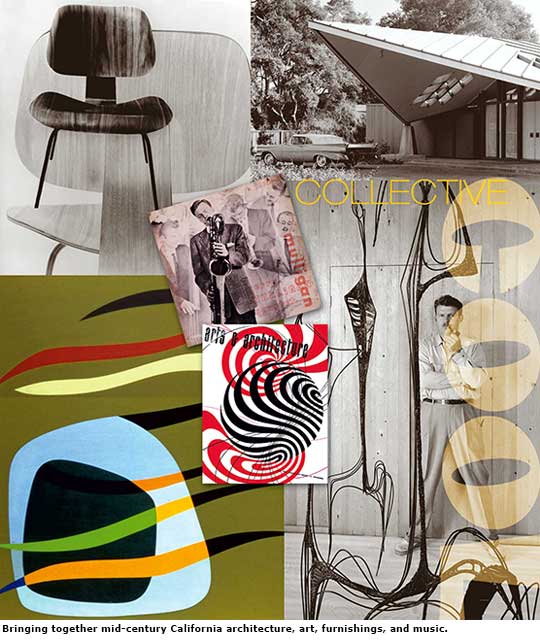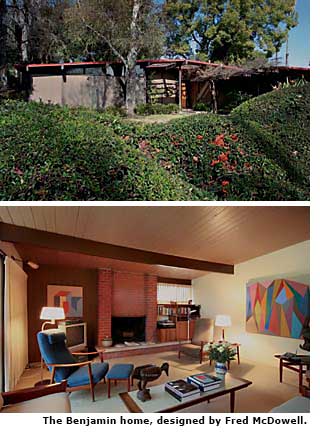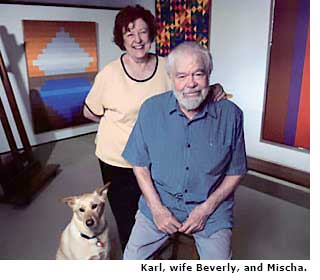Hello, Cool World: Painter, Karl Benjamin - Page 2
His paintings, moreover, go far to prove the curator's point that mid-century art and mid-century architecture are brothers under the skin. Benjamin was close friends with Claremont's leading modern architect, Fred McDowell, and had McDowell design the home where he has lived for more than half a century.
Benjamin's house is a classic mid-century modern California ranch, long and low, with a gabled roof over clerestoried glass, open beams and generous overhangs, an open floor plan, and a wall of glass facing the rear courtyard and the painter's studio. It looks in many ways like a Joe Eichler home, beautiful in its simplicity, with quiet lines, open spaces, and restrained decoration. What can be cooler than that? The structure is clearly apparent—much as the structure is apparent in Benjamin's paintings.

McDowell, who studied architecture at the University of Southern California, spent his career in the Claremont area, designing many custom homes, several small modern subdivisions, and college buildings.
"I really think this house was a great influence on me," says Benjamin, who knew little about modern architecture when he commissioned McDowell to design the house. "I got to become immediately a friend of Fred's. We went over the plans. I didn't understand what I was looking at it, so he explained why he did this and why he did that.
The resemblance between his paintings and McDowell's architecture became apparent to Benjamin only after the fact. The series of paintings most influenced by the house he named his 'post-and-beam' paintings, after the house's structural system.
The architect also noticed the resemblance, says his widow, Shirley McDowell, who remains friends with Benjamin and his wife, Beverly. When Fred McDowell chose a Benjamin painting to hang in their home, she says, "I said, 'I know why you chose that painting. It looks just like your architecture.' "
Armstrong sees other formal parallels between mid-century painting and mid-century architecture. "Just as the light-filled modernist house is open to the elements, with walls and ceilings seeming more like planes floating in space than enclosures," she writes, "hard-edge paintings of the period are characterized by a play between opaque and transparent forms, an instability of spatial division, and ambiguity between flatness and depth."

Among the artists and designers whose work makes up the 'Birth of the Cool' show are Charles and Ray Eames, furniture designers and architects; Julius Shulman, whose photos of elegant people in stark interiors made modernism appealing. The 'Birth of the Cool' catalogue also features classic and cool-as-glass Ernie Braun photos of Eichler homes.
One section of the catalogue focuses on William Claxton, the photographer and designer of record album covers, whose photos of Sonny Rollins, Chet Baker, and Gerry Mulligan defined the Los Angeles Cool Jazz scene. "The look of his photos was the way you wanted things to look," David Hickey writes in one essay, on Claxton and Cool Jazz. But it is the hard-edge mid-century painters whose work makes up the centerpiece of the show. Benjamin never thought of his art as 'cool,' and his approach to painting seems far from rational. Despite the work's hard-edge look, Benjamin works intuitively, not mathematically. And even though his brushstrokes are invisible, the act of painting is a sensuous one for Benjamin.
"An Abstract Classicist painting," Langsner wrote in the introduction to the 1959 show, "represents a rational crystallization of intuitive experience." Benjamin's work also suggests how Cool—both the general aesthetic and his particular paintings—had a social component. The Cool aesthetic, in many ways, was a quiet protest against the materialism of the 1950s, and to the increasingly paranoid Cold War world, complete with its McCarthy-ish witch-hunts and its missile races. Cool was a distancing technique, a stepping back from a world that was increasingly insane.

Benjamin, whose politics veers left, never saw his art as political, though he says that devoting ones life to abstract art is itself something of a political statement. He did produce a 'Viet Cong series,' he says, "after my students were kidding me about doing abstract paintings, not socially important things."
Benjamin showed his work at the Pasadena Museum in 1954—only a few years after creating his first painting. The Four Abstract Classicists show, which put him on the map, opened in San Francisco, showed in Los Angeles, and traveled to the East Coast and Europe.




